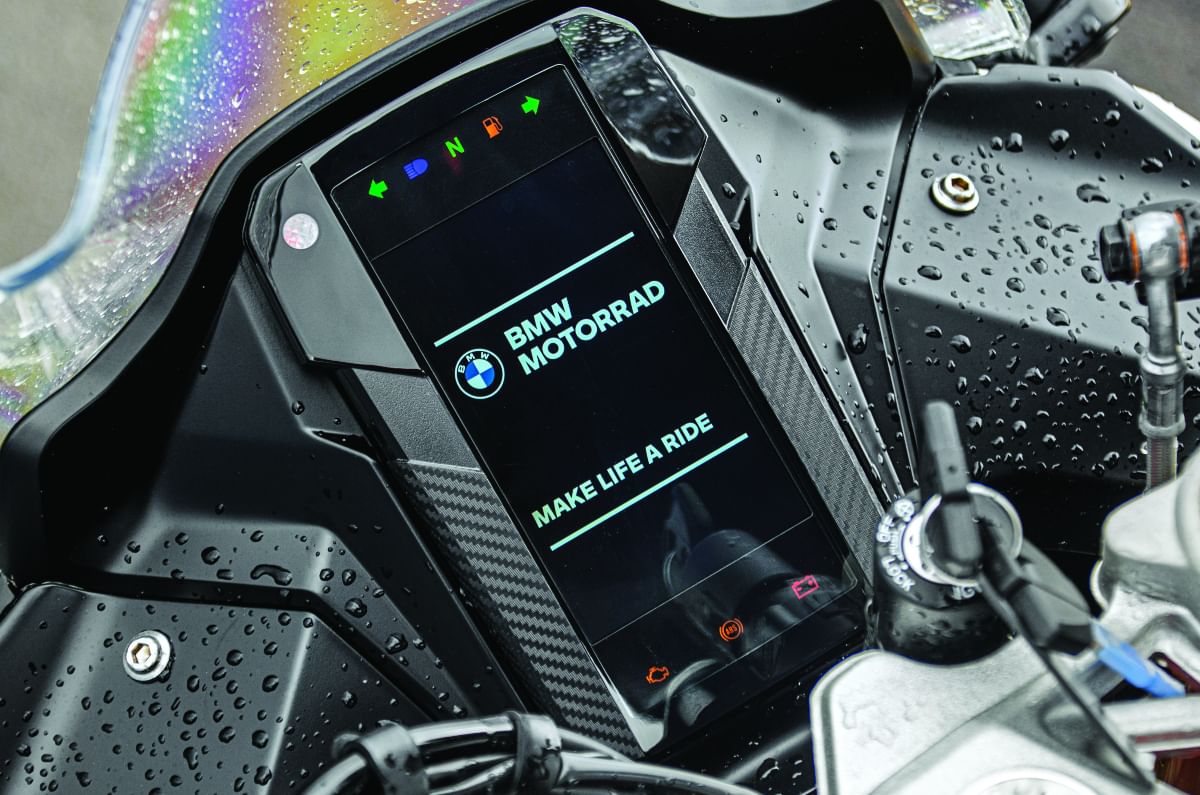BMW G 310 RR review: banking on the badge
BMW’s smallest faired bike yet is essentially a rebadged TVS Apache RR 310. But just how different is it?
Published on Sep 20, 2022 07:00:00 AM
80,864 Views
We Like
- Attractive design
- Badge value
We Don't Like
- Pricey
- Misses out on a few features
The new G 310 RR is the third product to come out of the collaboration between BMW and TVS, after the G 310 R street naked and the G 310 GS adventure motorcycles. However, unlike the previous two, which are BMW-unique products, the G 310 RR is essentially a rebadged version of TVS’ Apache RR 310. So just how different is the baby beemer to its Indian counterpart? Let’s find out.
BMW G 310 RR review: design and features
In terms of the styling, save for the BMW badging and the ‘Style Sport’ colour scheme our test bike is draped in, there isn’t anything to differentiate the G 310 RR from the Apache RR 310. The BMW features the same body panels, lights and alloy wheels as the TVS, however, the G 310 RR does look rather special in this iconic BMW white, red and blue livery. You’ll see heads turning quite frequently and people coming up to you to enquire more about this motorcycle. But, if you aren’t about grabbing attention, BMW also sells it in an all-black paint option which looks much more understated.
But while the BMW scores well on aesthetics, it does fall a bit short when it comes to features. The G 310 RR is near identical to the TVS in terms of equipment, with both featuring the same TFT screen, LED lighting and riding modes, but the BMW does miss out on Bluetooth connectivity – which unlocks a large number of features on the Apache.

The switchgear on the G 310 RR has been carried over unchanged from the TVS and the biggest compliment we can make is that it doesn’t feel out of place on a BMW. The quality of materials and the fit and finish is very good. The G 310 RR also gets BMW specific start up graphics for the TFT screen and a ‘BMW’ embossed into the key for an extra dose of specialness.
BMW G 310 RR review: engine and performance
The G 310 RR is mechanically identical to the RR 310, which means it’s powered by a 312.2cc, single-cylinder engine that makes 34hp and 27Nm, and comes mated to a 6-speed gearbox with a slip-and-assist clutch. The four riding modes – Track, Sport, Urban and Rain – remain unchanged from the TVS as well, differing in output figures (Urban and Rain reduce peak power and torque to 26hp and 25Nm), throttle response and ABS.
As expected, the engine feels pretty much the same as the Apache’s, and our test figures confirmed this – the BMW being more or less on par with the TVS. Overall, the G 310 RR feels like a quick and responsive motorcycle. The engine builds power in a linear manner all the way up to the redline. But, it isn’t the most refined unit as you can feel some vibrations higher up in the rev range.
BMW G 310 RR review: ride and handling
However, there’s a little more to differentiate when it comes to the underpinnings. Where the TVS uses petal-style brake discs and Michelin Road 5 tyres, the BMW comes equipped with conventional brake discs and Michelin Pilot Street tyres. While the difference with the rotors doesn’t affect the braking performance, the same can’t be said of the tyres. The Pilot Street tyres of the BMW are more than adequate for everyday use, but they just don’t provide you with the same amount of grip and feel as TVS’ Road 5 tyres when you start hustling the bike around – both in the dry, and especially, in the wet.
The suspension is yet another area of similarity between the BMW and the TVS as the set-up on the G 310 RR is exactly the same as the stock set-up on the standard Apache RR 310. However, TVS does offer adjustable suspension at both ends as a very reasonably priced option, which BMW doesn’t.
Still, BMW’s set-up manages to achieve a good balance between ride quality and sharp handling. It also does a good job of dealing with potholes and bumps, especially considering this is a sporty motorcycle. As a result, the G 310 RR feels composed at all speeds, which is confidence inspiring. Like the TVS, handling is one of the G 310 RR’s strong suits. The BMW is an involving handler and feels very easy and agile. The steering is quick and quite feelsome making it enjoyable around corners.
BMW G 310 RR review: verdict
The BMW G 310 RR comes across as a very appealing motorcycle, but at a price. Priced between Rs 2.85 lakh-2.99 lakh, the BMW costs Rs 20,000-34,000 more than the TVS, depending on the version. Considering that it is down on equipment too, over the TVS, the bike’s biggest asset is its badge. Judging solely by the price, it’s clear that BMW is aiming this motorcycle at buyers to whom brand value is of utmost importance. Just how many such buyers are out there remains to be seen.
Also see:
BMW Bikes Bikes
Related Videos
Tech Specs
| Wheels and Tyres | Petrol |
|---|---|
| Front Tyre | 110/70 R 17 |
| Rear Tyre | 150/60 R 17 |
| Dimensions & Chassis | Petrol |
|---|---|
| Weight (kg) | 174kg |
| Wheel base (mm) | 1365mm |
| Seat height(mm) | 811mm |
| Fuel Tank capacity (lts) | 11 litres |
| Price | Petrol |
|---|---|
| Price Range Ex-showroom - Delhi | Rs 2.85 lakh-2.99 lakh (ex-showroom, India) |
| Engine | Petrol |
|---|---|
| Fuel Type | Petrol |
| No of Cylinders | 1 |
| Cubic Capacity (cc) | 312cc |
| Cooling System | Liquid cooled |
| Max Power (hp @ rpm) | 34hp at 9700rpm (Sport/Track mode) |
| Max Torque (nm @ rpm) | 27.3Nm at 7700rpm (Sport/Track mode) |
| Transmission | Petrol |
|---|---|
| Gearbox Type | 6-speed |
| Braking | Petrol |
|---|---|
| 60 - 0 kph (mts, sec) | 16.93m |
| Acceleration | Petrol |
|---|---|
| 0 - 10 kph (sec) | 0.48s |
| 0 - 20 kph (sec) | 0.99s |
| 0 - 30 kph (sec) | 1.45s |
| 0 - 40 kph (sec) | 1.93s |
| 0 - 50 kph (sec) | 2.52s |
| 0 - 60 kph (sec) | 3.23s |
| 0 - 70 kph (sec) | 4.01s |
| 0 - 80 kph (sec) | 4.94s |
| 0 - 90 kph (sec) | 5.92s |
| 0 - 100 kph (sec) | 7.36s |
| Suspension | Petrol |
|---|---|
| Front Suspension | Upside down fork |
| Rear Suspension | monoshock |
| Brakes | Petrol |
|---|---|
| Front Brake Type | Disc |
| Rear Brake Type | Disc |
Copyright (c) Autocar India. All rights reserved.



